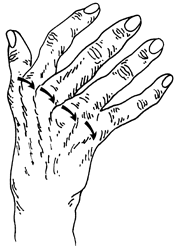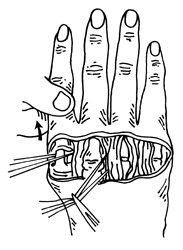|
MP Joint Arthritis
What is it?
The knuckle joints in the fingers act as hinges between the long bones in the
hand and the smaller bones in the fingers. These joints are called metacarpophalangeal
joints or MP joints of the hand. The MP joints are important to the hand for
gripping and holding things. Pain and deformity in the knuckle joints of the
fingers are common in rheumatoid arthritis. This pain and deformity may be caused
by trauma, gout, psoriasis, or other diseases. Diseases such as those mentioned
can injure the MP joints by ruining the structures and muscles that move the
joint, or by destroying the surface of the joint causing pain and deformity
in the knuckle.
What causes it?
There can be many reasons for these symptoms to occur. The ligaments that hold
the joint in place can be loosened by the disease, causing the joint to slip
out of place and eventually dislocate. The tendons at the top of the joint may
slip out of place and lose their ability to straighten the fingers.
Signs and symptoms
Difficulty in using the hand for daily activities (holding or gripping a cup,
tool, or eating utensils for example) is the most common complaint of patients
with MP joint disease. These problems in using the hand may be due to deformity,
pain, or both. Many patients notice their fingers slowly drifting (leaning)
to the little finger side of their hand. Daily activities may become more difficult
with time.
Treatment
Treating the symptoms can sometimes be done without surgery. Medication, splinting,
changes in daily activity, and injections of anti-inflammatory medicine may
be recommended by your hand surgeon in the early stages of MP joint disease.
If these forms of non-surgical treatment do not work, surgery may be needed.
Some advanced cases of MP joint disease may need surgery. Two types of surgery
are commonly performed. The first is generally done in less severe cases and
is called synovectomy or soft-tissue replacement. If the tendons have slipped
out of place, they are put back into place over the knuckle joint. If the small
muscles of the fingers are causing the fingers to lean toward the small fingers,
the muscles are operated on to stop the fingers from being pulled toward the
little finger. The second type of surgery is joint replacement and is generally
used on more severe cases of MP joint disease. The diseased metacarpophalangeal
joint is replaced with an artificial joint. Complications with this type of
surgery may happen. Infection is possible or the artificial joint may eventually
break or wear down. There is a possibility that a second replacement of the
joint or fusion of the joint may be recommended in later years.
The goals of treatment are pain relief and restored motion to the fingers.
Your hand surgeon can advise you on the best treatment for your situation.
Rehabilitation
Rehabilitation following joint replacement under the close supervision of your
hand surgeon is as important as the surgery. The hand is usually immobilized
for several days following surgery. A therapy program, consisting of exercises
and special splints, usually starts the first week after surgery and continues
for four to six weeks. In some cases the splinting portion of the program is
continued for a longer period of time.

Figure 1
Loss of position of tendons on top of MP joint result in loss of ability to
straighten fingers and the drift of fingers toward little finger-side of the
hand.

Figure 2
With joint replacement an artificial joint is placed between the bone ends and
tendons are repositioned. This procedure allows the fingers to straighten and
the drift is corrected.
Copyright © American Society for Surgery of the Hand.
All content copied with permission from ASSH (www.assh.org). |